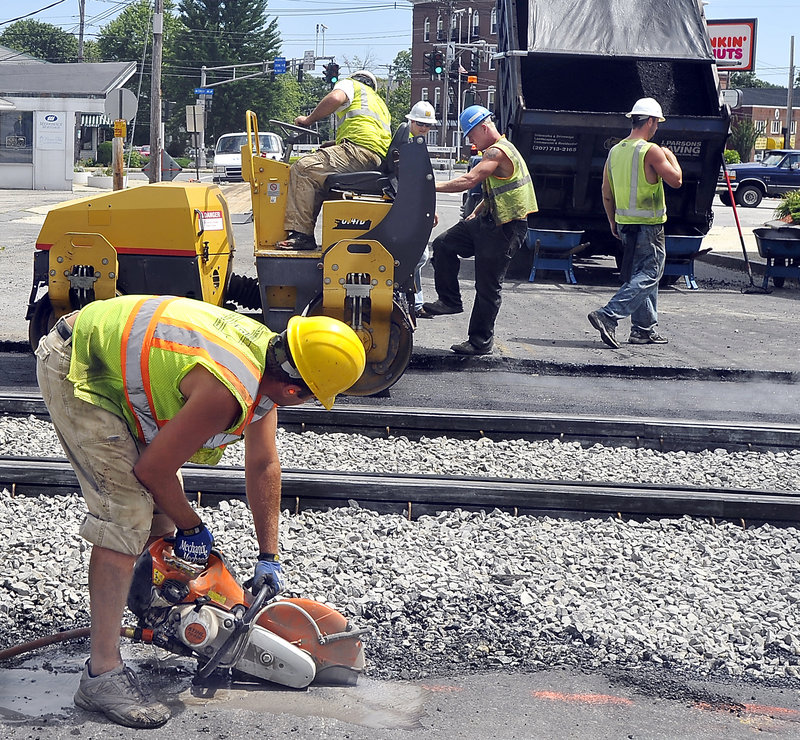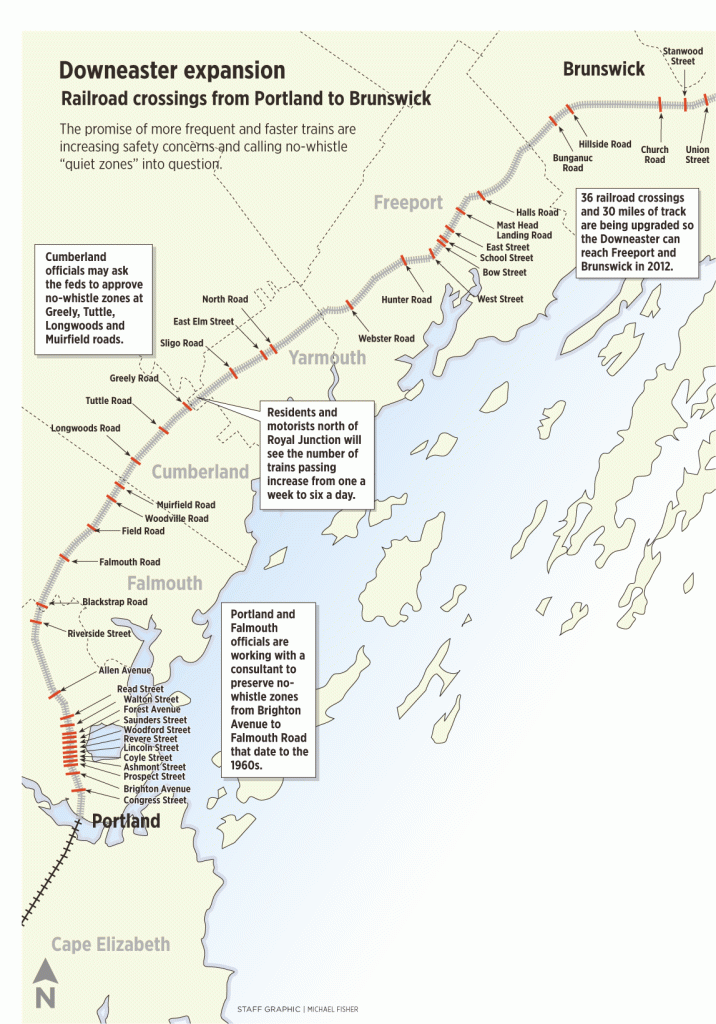Sixteen years ago, Mori and Carl LeFevre built their house next to the railroad crossing at Muirfield Road on the Falmouth-Cumberland town line.
They enjoy watching the freight trains that rumble by their sprawling single-family home near the Falmouth Country Club several times each day, Mori LeFevre said. Their two kids, ages 7 and 10, know they must stay away from the tracks. Sometimes the train whistles blow as they approach, sometimes they don’t.
When the Downeaster expands passenger service north to Freeport and Brunswick in late 2012, the LeFevres will see six additional trains pass each day. They’ll be traveling a lot faster and likely blasting the whistle every time. So, the couple would like to establish a “quiet zone” at the Muirfield Road crossing, where whistles would be banned except in emergencies.
“Every place you live has some issues,” LeFevre said. “I love living here, and part of me is excited to see the passenger trains go by. But as someone who’s had their house on the market in the past, people think they could never live near train tracks. I think it would be better if we had a quiet zone.”
From Portland to Brunswick, the planned expansion of Downeaster passenger service is rallying municipal officials and residents along the tracks to prepare for significant increases in train traffic, noise and safety concerns.
Several communities are taking steps to preserve existing no-whistle zones or seek new ones from the Federal Railroad Administration, which has strict criteria for approving either. The safety upgrades required for each quiet zone — such as additional gates, lights and traffic islands — could be costly and would be borne by each municipality.
At the same time, Amtrak and Pan Am Railways are upgrading 30 miles of track, as well as gates and signals at 36 crossings along the rail corridor, said Patricia Quinn, executive director of the Northern New England Passenger Rail Authority. Safety upgrades account for $9 million of the $38 million expansion project.
The changes are being made to accommodate five-car passenger trains that will travel 30 to 70 mph, depending on track conditions and population density. Freight trains currently run 10 to 20 mph in most areas, but can go as fast as 40 mph, Quinn said.
The number of trains also will increase. Three Downeaster round trips per day will pass through areas where most residents and motorists currently see four to eight freight trains per day, each with three locomotives and 50 cars.
The Downeaster’s impact will be relatively greater north of Royal Junction in Yarmouth, where only one freight train currently travels each week, Quinn said. Most freight trains on the Maine Line out of Portland head west at the junction, toward Lewiston-Auburn.
The Downeaster will be housed and maintained in Brunswick, where the first train will head out at 4:30 a.m. and the last train will return at 3 a.m., so its impact will be nearly around the clock.
With faster, more frequent trains, the Federal Railroad Administration is expected to take a closer look at safety conditions along the tracks. In particular jeopardy are long-established quiet zones at crossings in Portland, Falmouth and Brunswick.
While officials in those towns are taking steps to preserve or expand their no-whistle zones, Cumberland and Freeport officials are looking into establishing new no-whistle zones.
The prospect of keeping or adding quiet zones will be difficult and could be costly, especially if federal officials require four-quadrant gates that prevent motorists from driving around typical two-gate crossings, said Wayne Duffett, a consulting railroad engineer with TEC Associates of South Portland.
“You’re looking at $100,000 to $300,000 per crossing, and that’s just an estimate,” Duffett said.
The cost would be determined by Pan Am Railways, which owns the tracks and does the work, and paid for by the municipality, Duffett said. On top of that, the criteria for establishing a new quiet zone are much more stringent than they are for maintaining an existing one.
Duffett is working with Portland and Falmouth officials in anticipation of possible federal action to rescind 15 no-whistle zones in a 6-mile stretch from Brighton Avenue to Falmouth Road. Records show that the quiet zones were established as early as the 1960s, Duffett said.
Portland’s no-whistle zones at Forest Avenue and Riverside Street were called into question in 2009, following non-fatal motor vehicle-train accidents at those crossings in 2008, Duffett said.
The city has until the end of 2012 to upgrade safety precautions at those crossings or risk losing the no-whistle zone designation, though Duffett has challenged the way federal officials calculated the safety risk at each intersection following the accidents.
Falmouth’s no-whistle zone at Blackstrap Road is expected to be targeted in early 2012, a year after a non-fatal accident at that crossing in January, Duffett said. Falmouth officials will have six months to file a plan to increase safety precautions at the intersection and three years to implement the plan before federal officials consider rescinding the quiet zone.
The Cumberland Town Council is expected to discuss a proposal Monday night to seek quiet zones at Longwoods, Tuttle, Greely and Muirfield roads, according to Town Manager Bill Shane. Cumberland is one town that’s also talking about asking Pan Am Railways to install underground conduits at crossings now so adding safety upgrades would be easier and less costly in the future.
Brunswick officials have begun preliminary discussions about extending an existing quiet zone west beyond the Maine Street crossing, said Town Manager Gary Brown.
And in Freeport, officials are considering the need for quiet zones and the related cost of upgrading safety gates, signals and traffic islands at seven crossings in that town.
“We’re thoroughly researching what’s involved and what the cost might be,” said Sande Updegraph, executive director of the Freeport Economic Development Corp.
In Yarmouth, Town Manager Nat Tupper said he’s not planning to seek no-whistle zones, but he’s anticipating increased public concern when the Downeaster starts moving through town at 30 to 60 mph. Freight trains have traveled there occasionally for the past 50 years.
“We don’t have a snowball’s chance of getting a quiet zone, and I don’t think it’s a good idea,” Tupper said. “Nobody living near the tracks likes train whistles, but everybody hates tragic accidents.”
The Northern New England Passenger Rail Authority used existing quiet zones to show that expanding Downeaster service to Brunswick would have “no significant impact” on noise levels near the tracks, according to a 2009 environmental assessment submitted to and approved by the Federal Railroad Administration.
The authority plans to accommodate future federal decisions adding or removing quiet zones, though its administrators express a firm preference for allowing engineers to blow their whistles before each crossing.
“Safety is our No. 1 concern,” Quinn said. “We’re using a transportation corridor for its intended use. If you live near railroad tracks, there’s a chance that a train will go by. The public is responsible for paying attention to traffic signals on a railroad as they would be for a regular road, and any effort to reduce those signals has to be a thoughtful decision made with public safety in mind.”
The authority plans to mount a public education campaign in January to inform schoolchildren and others about changing transportation and safety conditions related to the Downeaster’s expansion.
They’ll be targeting people who live near the tracks and use them as a recreational trail, even though walking or riding along the railroad right of way is illegal. Violators could be charged with trespassing by Pan Am Railways or the Maine Department of Transportation.
“It’s not a playground or a recreational trail. It’s not a place to walk your dog, ride your ATV or play, ever,” Quinn said. “You wouldn’t walk with your child down the middle of a road. You wouldn’t walk down the middle of a road listening to an iPod. We see that happen a lot. Ultimately, if you stay out of the railroad right of way, you will be safe.”
Though Mori LeFevre would like a no-whistle zone near her home on Muirfield Road, she agrees that the public must respect the railroad right of way. She often sees people riding ATVs and dirt bike along the tracks. Even the occasional “moron” in a car or truck.
“People have to have common sense,” LeFevre said. “You wouldn’t play in the middle of a highway.”
Staff Writer Kelley Bouchard can be contacted at 791-6328 or at:
kbouchard@pressherald.com
Send questions/comments to the editors.




Success. Please wait for the page to reload. If the page does not reload within 5 seconds, please refresh the page.
Enter your email and password to access comments.
Hi, to comment on stories you must . This profile is in addition to your subscription and website login.
Already have a commenting profile? .
Invalid username/password.
Please check your email to confirm and complete your registration.
Only subscribers are eligible to post comments. Please subscribe or login first for digital access. Here’s why.
Use the form below to reset your password. When you've submitted your account email, we will send an email with a reset code.